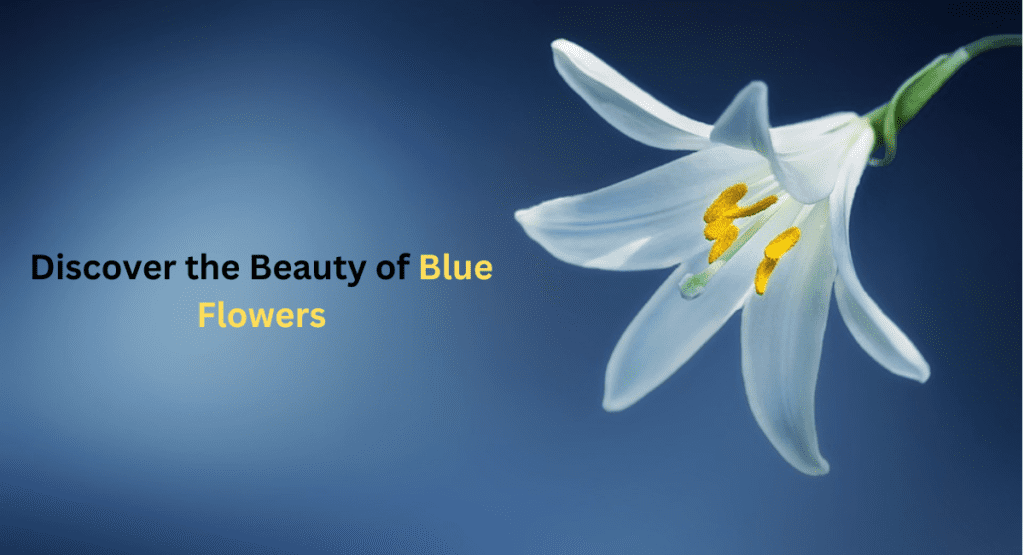Blue flowers are some of the most beautiful and unique blooms found in the plant world. Their striking blue coloration is both calming and mesmerizing, making them a favorite among gardeners, florists, and flower enthusiasts alike. In this article, we will explore the names of some of the most popular blue flowers and learn more about their characteristics.
Blue flowers are a stunning addition to any garden, bringing a touch of tranquility and elegance to your outdoor space. The color blue is associated with calmness and serenity, making blue flowers a popular choice for those who want to create a relaxing and peaceful atmosphere. In this post, we’ve compiled a list of 10 of the most beautiful blue flowers you can plant in your garden.
Want to learn all flower’s name? this blog will help you to find all the flower’s names in English and all language as well.
Read More:
Table of Contents
Toggle31 Blue Flowers Name List

#1.Grape Hyacinth
Grape Hyacinths, also known as Muscari, are a charming and easy-to-grow flower that produces beautiful blue blooms. These flowers are perfect for borders, rock gardens, and container plantings. In this post,
- Scientific Name: Muscari armeniacum
- Plant Type: Bulbous perennial plant
- Sunlight Needs: Thrives in full sun to partial shade, Can tolerate shade but may produce fewer flowers
Plant Size:
- Grows to be around 6-8 inches in height
- Forms clumps of narrow, grass-like leaves with spikes of small, bell-shaped flowers
Growing Zones:
- Grape Hyacinth is hardy in USDA zones 3-9
- Can be grown as an annual in warmer climates
Soil Needs:
- Prefers well-draining soil
- Can tolerate poor soil, but benefits from the addition of organic matter
- pH level should be between 6.0 and 7.5

#2. Lily Of The Nile
Lily of the Nile, also known as Agapanthus, is a stunning flowering plant that produces clusters of blue or white flowers atop tall stalks. Here is some information about the Lily of the Nile:
- Scientific Name: Agapanthus africanus
- Plant Type: Perennial herbaceous plant
Sunlight Needs:
- Thrives in full sun to partial shade
- Needs at least 4-6 hours of direct sunlight per day
Plant Size:
- Can grow up to 4 feet tall and 2-3 feet wide, depending on the variety
- Has a clumping habit with long, strap-like leaves
Growing Zones:
- Lily of the Nile is hardy in USDA zones 8-11
- Can be grown as an annual in cooler climates
Soil Needs:
- Prefers well-draining soil
- Needs a pH level between 6.0 and 7.5
- Benefits from the addition of organic matter to the soil
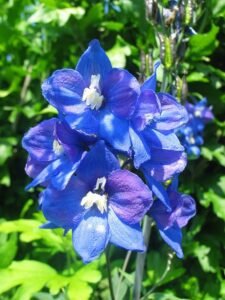
#3.Blue Delphinium
Blue Delphinium is a tall and striking perennial plant that is known for its showy spikes of blue flowers. Here is some information about the Blue Delphinium:
- Scientific Name: Delphinium elatum
- Plant Type: Perennial herbaceous plant
Sunlight Needs:
- Prefers full sun, but can tolerate partial shade
- Needs at least 6 hours of direct sunlight per day
Plant Size:
- Can grow up to 6 feet tall and 2-3 feet wide, depending on the variety
- Has a columnar habit with multiple stems
Growing Zones:
- Blue Delphiniums are hardy in USDA zones 3-7
- Can be grown as an annual in warmer climates
Soil Needs:
- Prefers well-draining soil
- Needs a pH level between 6.0 and 7.5
- Benefits from the addition of organic matter to the soil

#4. Cornflower
Cornflower, also known as Bachelor’s Button, is a beautiful flowering plant that is known for its bright blue color. Here is some information about the Cornflower:
- Scientific Name: Centaurea cyanus
- Plant Type: Annual or biennial herbaceous plant
Sunlight Needs:
- Prefers full sun, but can tolerate partial shade
- Needs at least 6 hours of direct sunlight per day
Plant Size:
- Can grow up to 3 feet tall, but is typically around 1-2 feet in height
- Grows in a clump with a spread of about 1 foot
Growing Zones:
- Cornflowers are hardy in USDA zones 2-11
- Can be grown as an annual or biennial, depending on the climate
Soil Needs:
- Prefers well-draining soil
- Can tolerate poor soil, but thrives in fertile soil
- pH level should be between 6.0 and 7.5
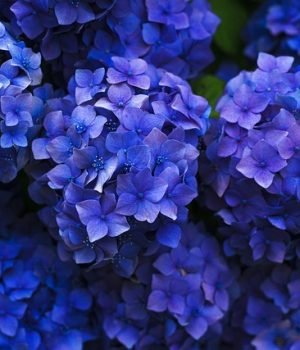
#5.Hydrangea
Hydrangeas are a group of flowering plants that are known for their large, showy blooms and lush foliage. :
- Scientific Name: Hydrangea macrophylla
- Plant Type: Deciduous shrub
Sunlight Needs:
- Thrives in partial shade to full sun, depending on the variety
- Generally prefers morning sun and afternoon shade in hot climates
Plant Size:
- Can grow up to 6-8 feet tall and wide, depending on the variety
- Some dwarf varieties can reach a height of only 2-3 feet
Growing Zones:
- Hydrangeas are hardy in USDA zones 3-9, depending on the variety
- Generally, the mophead and lacecap varieties are hardy in colder zones, while the oakleaf and panicle varieties are hardy in warmer zones
Soil Needs:
- Prefers moist, well-drained soil
- Acidic soil with a pH between 5.2 and 6.2 is ideal for blue flowers
- Alkaline soil with a pH between 6.2 and 7.5 is ideal for pink flowers
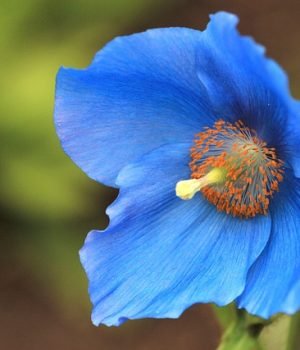
#6.Himalayan Blue Poppies
Himalayan Blue Poppies, also known as Meconopsis, are a rare and beautiful flower that produces stunning blue blooms. These flowers are native to the Himalayas and can be challenging to grow, but the effort is well worth it for their breathtaking beauty.
- Scientific Name: Meconopsis betonicifolia
- Plant Type: Herbaceous perennial plant
Sunlight Needs:
- Prefers partial shade to full shade
- Needs protection from direct afternoon sun
Plant Size:
- Can grow up to 3-4 feet tall and 1-2 feet wide
- Forms clumps of hairy, lobed leaves with striking blue flowers on tall stems
Growing Zones:
- Himalayan Blue Poppies are hardy in USDA zones 6-9
- Can be grown as an annual in cooler climates
Soil Needs:
- Prefers well-draining soil
- Needs a pH level between 5.5 and 6.5
- Benefits from the addition of organic matter to the soil

#7.Forget-Me-Nots
Forget-Me-Nots, also known as Myosotis, are a beloved flower that produces charming blue blooms. These flowers are perfect for borders, rock gardens,
- Scientific Name: Myosotis sylvatica
- Plant Type: Herbaceous biennial or perennial plant
Sunlight Needs:
- Thrives in partial shade to full shade
- Can tolerate some morning sun, but needs protection from hot afternoon sun
Plant Size:
- Grows to be around 6-12 inches tall and 6-8 inches wide
- Forms clumps of small, oval-shaped leaves with delicate clusters of small blue, pink, or white flowers
Growing Zones:
- Forget-Me-Nots are hardy in USDA zones 3-8
- Can be grown as an annual in warmer climates
Soil Needs:
- Prefers moist, well-draining soil
- Can tolerate poor soil, but benefits from the addition of organic matter
- pH level should be between 6.0 and 7.5
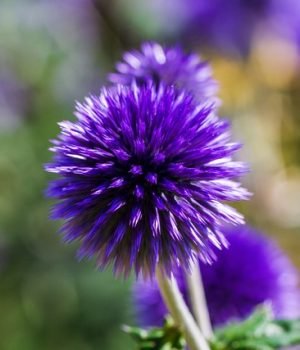
#8.Globe Thistle
Globe Thistle, also known as Echinops, is a unique blue flower that is sure to make a statement in your garden. With its spiky spherical blooms,
- Scientific Name: Echinops ritro
- Plant Type: Herbaceous perennial plant
Sunlight Needs:
- Thrives in full sun to partial shade
- Can tolerate some shade, but may produce fewer flowers
Plant Size:
- Can grow to be around 3-5 feet tall and 2-3 feet wide
- Forms clumps of deeply lobed, spiky leaves with round, spiky, blue or white flower heads
Growing Zones:
- Globe Thistle is hardy in USDA zones 3-8
Soil Needs:
- Prefers well-draining soil
- Can tolerate poor soil, but benefits from the addition of organic matter
- pH level should be between 6.0 and 7.5

#9.Sea Holly
Sea Holly, or Eryngium, is a striking blue flowering plant that will add a unique touch to your garden. With its spiky texture and metallic blue color, it’s sure to catch the eye of any passerby
- Plant Type: Herbaceous perennial plant
- Sunlight Needs: Thrives in full sun to partial shade, Can tolerate some shade, but may produce fewer flowers
Plant Size:
- Can grow to be around 1-3 feet tall and 1-2 feet wide
- Forms clumps of spiky, blue-green leaves with distinctive, round, spiky, metallic-blue or silver flower heads
Growing Zones:
- Sea Holly is hardy in USDA zones 5-9
Soil Needs:
- Prefers well-draining, sandy or rocky soil
- Can tolerate poor soil and drought conditions
- pH level should be between 6.0 and 7.5

#10.Flax Flower
Flax flower, also known as Linum, is a stunning blue flowering plant that can add a burst of color to any garden. With its delicate blooms and easy care, it’s a great choice for both novice and experienced gardeners alike.
- Plant Size:
- Can grow to be around 1-2 feet tall and 1-2 feet wide
- Forms clumps of slender, green foliage with delicate, blue or white flowers
Growing Zones:
- Flax Flower is hardy in USDA zones 5-9
Soil Needs:
- Prefers well-draining soil
- Can tolerate poor soil and drought conditions
- pH level should be between 6.0 and 7.5

#11.Empire Blue Butterfly Bush
Sunlight Needs:
- Thrives in full sun
- Can tolerate some light shade
Plant Size:
- Can grow to be around 6-8 feet tall and wide
- Forms a rounded shape with arching branches
- Leaves are gray-green and slightly hairy, while flowers are fragrant and blue-purple in color
Growing Zones:
- Empire Blue Butterfly Bush is hardy in USDA zones 5-9
Soil Needs:
- Prefers well-draining soil
- Can tolerate a wide range of soil types, including sandy or clay soils
- Soil pH should be between 6.0 and 7.5
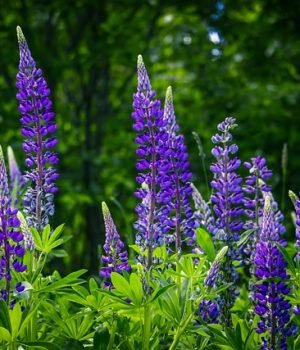
#12.Lupine
Blue lupine, also known as lupinus polyphyllus, is a stunning flowering plant that can add a splash of color and texture to any garden. With its tall spikes of vibrant blue flowers, blue lupine is a popular choice for borders, beds, and meadows. In this post,
- Scientific Name: Lupinus
- Plant Type: Herbaceous perennial
Sunlight Needs:
- Thrives in full sun to partial shade
- Can tolerate some shade, but may not flower as well
Plant Size:
- Can grow to be around 1-4 feet tall and 1-3 feet wide, depending on the species and cultivar
- Forms a clump of palmate leaves, with tall spikes of flowers rising above
- Flowers can be blue, purple, pink, red, white, or yellow, depending on the species and cultivar
Growing Zones:
- Lupines are hardy in USDA zones 3-9, depending on the species and cultivar
Soil Needs:
- Prefers well-draining soil
- Soil pH should be between 6.0 and 7.5
- Can tolerate poor soil conditions, but may not thrive in heavy clay soils
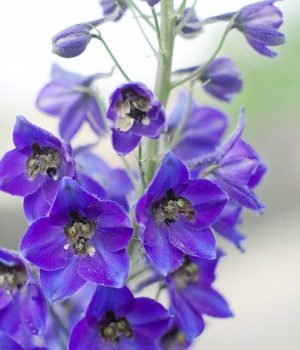
#13.Delphinium
Blue Delphinium, also known as Delphinium elatum, is a beautiful flowering plant that can add height, color, and drama to any garden. With its tall spikes of vibrant blue flowers, blue Delphinium is a popular choice for borders,
- Scientific Name: Delphinium
- Plant Type: Perennial
- Sunlight Needs: Full sun to partial shade
- Plant Size: Varies depending on species and cultivar, typically 3-6 feet tall and 1-3 feet wide
- Growing Zones: Varies depending on species and cultivar, typically zones 3-8
- Soil Needs: Well-draining soil that is moist but not waterlogged

#14.Clematis
Blue Clematis is a stunning flowering vine that can add a touch of elegance and beauty to any garden. With its delicate, bell-shaped blue flowers
- Scientific Name: Clematis
- Plant Type: Perennial vine
- Sunlight Needs: Full sun to partial shade, depending on the variety
- Plant Size: Varies depending on species and cultivar, typically 6-20 feet tall and 3-10 feet wide
- Growing Zones: Varies depending on species and cultivar, typically zones 4-9
- Soil Needs: Well-draining soil that is moist but not waterlogged, and fertile soil with a pH of 6-7
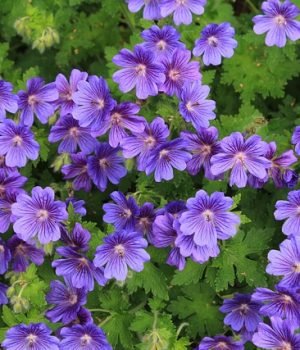
#15.Perennial Geranium
Perennial Geranium, also known as cranesbill, is a beautiful and versatile flowering plant that can add color, texture, and interest to any garden. With its vibrant blue flowers and easy-to-care-for nature,
- Scientific Name: Geranium spp.
- Plant Type: Herbaceous perennial
- Sunlight Needs: Part to full sun
- Plant Size: Can grow up to 2 feet tall and wide
- Growing Zones: Typically zones 4-8, but can vary by species
- Soil Needs: Well-draining soil that is moist but not waterlogged. Tolerates a range of soil types.
- Hope this helps!
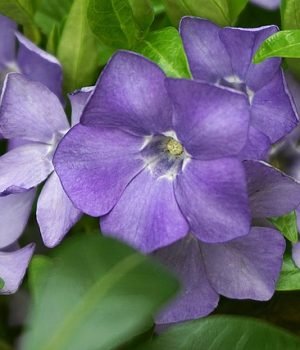
#16.Periwinkle
Heliotrope flowers are known for their sweet, vanilla-like fragrance, which is most pronounced in the evening. The flowers are small, typically purple or white, and arranged in clusters that can be 4-6 inches (10-15 cm) across.
- Scientific Name: Heliotropium arborescens
- Plant Type: Heliotrope is a shrub-like, herbaceous perennial plant that is grown for its fragrant, showy flowers.
- Sunlight Needs: Heliotrope prefers full sunlight to partial shade.
- Plant Size: The size of the Heliotrope plant can vary depending on the cultivar and growing conditions, but on average it grows to be about 1-3 feet (30-90 cm) tall and 1-2 feet (30-60 cm) wide.
- Growing Zones: Heliotrope is hardy in USDA growing zones 10-11, but can be grown as an annual in cooler climates. It is native to Peru and Ecuador.
- Soil Needs: Heliotrope prefers well-draining soil that is slightly acidic to neutral (pH 6.0-7.0). It is moderately tolerant of drought and heat, but requires regular watering in hot, dry weather.
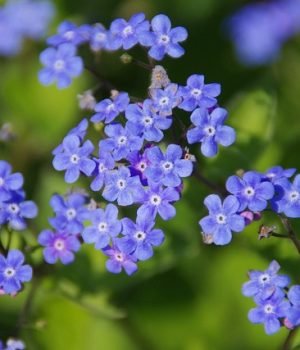
#17. Brunnera
Hardy Geranium flowers come in a range of colors, including pink, purple, blue, and white. The flowers are typically arranged in clusters or umbels, and are attractive to bees and other pollinators. The foliage of Hardy Geraniums is often highly ornamental, and can be variegated or deeply lobed.
- Scientific Name: Geranium spp.
- Plant Type: Hardy Geraniums, also known as Cranesbills, are herbaceous perennials that are grown for their attractive foliage and showy flowers.
- Sunlight Needs: Hardy Geraniums prefer full sunlight to partial shade.
- Plant Size: The size of the Hardy Geranium plant can vary depending on the cultivar and growing conditions, but on average it grows to be about 1-2 feet (30-60 cm) tall and wide.
- Growing Zones: Hardy Geraniums are generally hardy in USDA growing zones 4-8, depending on the cultivar. They are native to temperate regions of the Northern Hemisphere.
- Soil Needs: Hardy Geraniums prefer well-draining soil that is slightly acidic to neutral (pH 6.0-7.0). They are generally tolerant of a range of soil types and moisture levels.
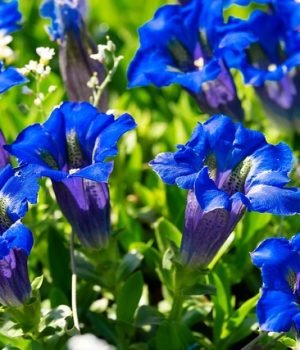
#18. Gentian
Dendrobium Orchids are known for their showy and exotic flowers, which can come in a wide range of colors and patterns. The flowers are typically arranged in racemes or panicles and are attractive to butterflies and other pollinators. The foliage of Dendrobium Orchids is often highly ornamental,
- Scientific Name: Dendrobium spp.
- Plant Type: Dendrobium Orchids are a diverse group of epiphytic or lithophytic orchids that are prized for their beautiful and exotic flowers.
- Sunlight Needs: Dendrobium Orchids prefer bright, indirect light. They can be grown in full sun if protected from the hottest rays, but also can be grown in low light conditions.
- Plant Size: The size of the Dendrobium Orchid plant can vary depending on the species and growing conditions, but on average they grow to be about 1-4 feet (30-120 cm) tall.
- Growing Zones: Dendrobium Orchids are commonly grown as houseplants, but some species can be grown outdoors in tropical or subtropical regions. They are native to a wide range of regions, including Asia, Australia, and the Pacific Islands.
- Soil Needs: Dendrobium Orchids do not require soil and are typically grown in a well-draining potting mix that is specifically formulated for orchids. They require a mix that has a lot of air and drainage, like bark chips, perlite, or sphagnum moss.

#19.Hyacinth
Coneflowers are known for their showy, daisy-like flowers, which can come in a wide range of colors including pink, purple, white, and yellow. The flowers are typically arranged in a cone-shaped center, surrounded by drooping petals. Coneflowers are attractive to bees,
- Sure, here is some information about the coneflower:
- Scientific Name: Echinacea spp.
- Plant Type: Coneflowers are herbaceous perennials that are grown for their attractive flowers and drought tolerance.
- Sunlight Needs: Coneflowers prefer full sunlight, but can also tolerate partial shade.
- Plant Size: The size of the coneflower plant can vary depending on the cultivar and growing conditions, but on average they grow to be about 1-3 feet (30-90 cm) tall and 1-2 feet (30-60 cm) wide.
- Growing Zones: Coneflowers are hardy in USDA growing zones 3-9, depending on the cultivar. They are native to the prairies and woodlands of North America.
- Soil Needs: Coneflowers prefer well-draining soil that is slightly acidic to neutral (pH 6.0-7.0). They are tolerant of a range of soil types and moisture levels, but prefer soil that is not overly wet.
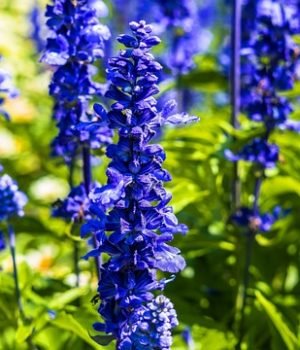
#20.Salvia
Cattleya Orchids are known for their large and colorful flowers, which can come in a wide range of colors and patterns. The flowers are typically arranged in a spray or raceme, and can be highly fragrant. Cattleya Orchids are prized for their ornamental foliage, which can be broad
- Scientific Name: Cattleya spp.
- Plant Type: Cattleya Orchids are a group of epiphytic or lithophytic orchids that are prized for their showy and fragrant flowers.
- Sunlight Needs: Cattleya Orchids prefer bright, indirect light. They can tolerate some direct sunlight, but should be protected from the hottest rays.
- Plant Size: The size of the Cattleya Orchid plant can vary depending on the species and growing conditions, but on average they grow to be about 1-2 feet (30-60 cm) tall and wide.
- Growing Zones: Cattleya Orchids are typically grown as houseplants, but some species can be grown outdoors in warm, humid climates. They are native to Central and South America.
- Soil Needs: Cattleya Orchids do not require soil and are typically grown in a well-draining potting mix that is specifically formulated for orchids. They require a mix that has a lot of air and drainage, like bark chips, perlite, or sphagnum moss.

#21.Passionflower
Hollyhocks are known for their tall, stately flower spikes, which can come in a wide range of colors including pink, red, yellow, white, and purple. The flowers are arranged in a raceme, and are typically large and showy with a distinctive central stamen. Hollyhocks are attractive to bees and butterflies, and are often used in cottage gardens and as background plantings. T
- Scientific Name: Alcea spp.
- Plant Type: Hollyhocks are herbaceous biennials or short-lived perennials that are grown for their tall, showy flower spikes.
- Sunlight Needs: Hollyhocks prefer full sun, but can tolerate some light shade in the hottest part of the day.
- Plant Size: Hollyhocks can grow to be quite tall, typically reaching heights of 5-8 feet (1.5-2.4 m) or more, depending on the variety.
- Growing Zones: Hollyhocks are hardy in USDA growing zones 3-9, depending on the variety. They are native to Europe and Asia.
- Soil Needs: Hollyhocks prefer fertile, well-draining soil that is slightly acidic to neutral (pH 6.0-7.0). They are tolerant of a range of soil types, but do best in soil that is rich in organic matter.

#22.Bellflower
Anemones are known for their colorful, daisy-like flowers, which can come in a wide range of colors including white, pink, red, and blue. The flowers are arranged in a single or double layer of petals and have a distinctive central disc. Anemones are attractive to bees and butterflies,
- Scientific Name: Anemone spp.
- Plant Type: Anemones are herbaceous perennials that are grown for their showy, daisy-like flowers.
- Sunlight Needs: Anemones prefer partial shade to full sun, depending on the variety.
- Plant Size: Anemones can range in size from dwarf varieties that grow only a few inches tall to taller varieties that can reach heights of 2-4 feet (60-120 cm).
- Growing Zones: Anemones are hardy in USDA growing zones 4-8, depending on the variety. Some species are native to North America, while others are native to Europe and Asia.
- Soil Needs: Anemones prefer well-draining soil that is rich in organic matter. They prefer slightly acidic soil (pH 6.0-7.0) and may benefit from an annual application of compost or organic fertilizer.

#23. Glory-of-the-snow
Lily of the Nile is known for its striking, globe-shaped flower clusters, which can come in a range of blue, purple, white, and pink shades. The flowers are arranged in an umbel, and are typically quite showy with long, strap-like petals. Lily of the Nile is attractive to bees and butterflies,
- Scientific Name: Agapanthus spp.
- Plant Type: Lily of the Nile is a herbaceous perennial that is grown for its striking, globe-shaped flower clusters.
- Sunlight Needs: Lily of the Nile prefers full sun to partial shade.
- Plant Size: Lily of the Nile can grow to be quite large, typically reaching heights of 2-4 feet (0.6-1.2 m) and widths of 1-3 feet (0.3-0.9 m).
- Growing Zones: Lily of the Nile is hardy in USDA growing zones 8-11. It is native to South Africa.
- Soil Needs: Lily of the Nile prefers well-draining soil that is rich in organic matter. It can tolerate a range of soil types, but does best in soil that is slightly acidic to neutral (pH 6.0-7.0).
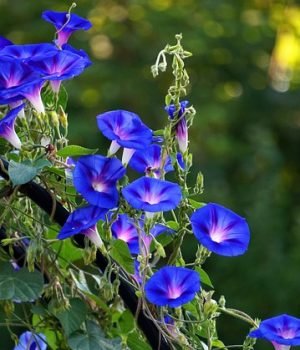
#24. Morning glory
Catmint is known for its aromatic, gray-green foliage and showy spikes of lavender-blue flowers. The flowers are attractive to bees, butterflies, and hummingbirds. Catmint is often used in borders, rock gardens,
- Scientific Name: Nepeta spp.
- Plant Type: Catmint is a herbaceous perennial that is grown for its attractive foliage and showy, aromatic flowers.
- Sunlight Needs: Catmint prefers full sun, but can tolerate some light shade.
- Plant Size: Catmint can grow to be 1-3 feet (0.3-0.9 m) tall and wide, depending on the variety.
- Growing Zones: Catmint is hardy in USDA growing zones 3-8, depending on the variety. It is native to Europe and Asia.
- Soil Needs: Catmint prefers well-draining soil that is moderately fertile. It can tolerate a range of soil types, but does best in soil that is neutral to slightly alkaline (pH 6.0-7.5).

#25.Veronica
Iris Pumila is known for its attractive, showy flowers that come in a range of colors, including purple, blue, pink, white, and yellow. The flowers are arranged in a fan shape, with three petals and three sepals.
- Scientific Name: Iris pumila
- Plant Type: Iris Pumila is a herbaceous perennial that is grown for its attractive flowers.
- Sunlight Needs: Iris Pumila prefers full sun, but can tolerate some light shade.
- Plant Size: Iris Pumila typically grows to be 6-8 inches (15-20 cm) tall, with a spread of 12-18 inches (30-45 cm).
- Growing Zones: Iris Pumila is hardy in USDA growing zones 3-9.
- Soil Needs: Iris Pumila prefers well-draining soil that is slightly acidic to neutral (pH 6.0-7.0). It can tolerate a range of soil types, but does best in soil that is not too wet.
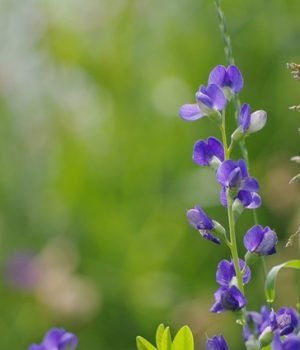
#26.Blue false indigo
Purple Pansies are part of the viola family and are known for their attractive, heart-shaped flowers. The flowers come in a range of colors including purple, yellow, white, blue, and red. Purple Pansies are often used in borders,
- Scientific Name: Viola tricolor hortensis
- Plant Type: The Purple Pansy is a herbaceous biennial or annual flowering plant that is grown for its colorful flowers.
- Sunlight Needs: Purple Pansies prefer full sun to partial shade.
- Plant Size: Purple Pansies can grow up to 6-9 inches (15-23 cm) tall and can spread up to 9-12 inches (23-30 cm) wide.
- Growing Zones: Purple Pansies are hardy in USDA growing zones 4-8.
- Soil Needs: Purple Pansies prefer well-drained soil that is moist and fertile. The soil pH should be neutral to slightly alkaline (pH 6.0-7.5).
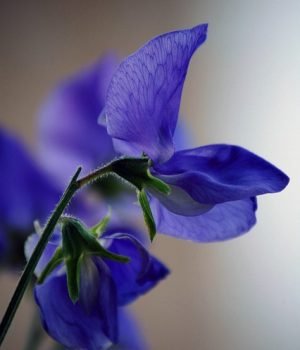
#27.Sweet Pea
Annual Honesty is known for its attractive, fragrant flowers that come in shades of purple, pink, and white. The flowers are arranged in clusters at the top of the stem. After the flowers have faded, the plant produces unique,
- Scientific Name: Lunaria annua
- Plant Type: Annual Honesty is an herbaceous biennial or annual flowering plant that is grown for its attractive flowers and unique seed pods.
- Sunlight Needs: Annual Honesty prefers full sun to partial shade.
- Plant Size: Annual Honesty can grow up to 2-3 feet (60-90 cm) tall and can spread up to 1-2 feet (30-60 cm) wide.
- Growing Zones: Annual Honesty is hardy in USDA growing zones 4-8.
- Soil Needs: Annual Honesty prefers well-drained soil that is moist and fertile. The soil pH should be neutral to slightly alkaline (pH 6.0-7.5).
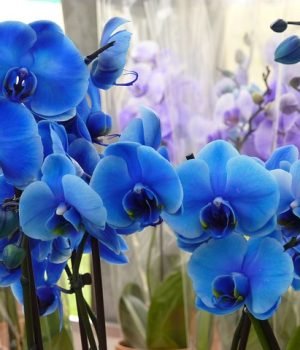
#28. orchidgb1550c330_640
Bee Orchid is named for its flowers, which resemble a female bee and attract male bees for pollination. The flowers are generally pinkish-purple with a large, furry lip that resembles a bee. Bee Orchid is native to Europe and can be found in meadows, grasslands,
- Scientific Name: Ophrys apifera
- Plant Type: Bee Orchid is a perennial flowering plant that is grown for its unique and showy flowers.
- Sunlight Needs: Bee Orchid prefers full sun to partial shade.
- Plant Size: Bee Orchid can grow up to 12-24 inches (30-60 cm) tall and can spread up to 6-12 inches (15-30 cm) wide.
- Growing Zones: Bee Orchid is hardy in USDA growing zones 6-9.
- Soil Needs: Bee Orchid prefers well-drained soil that is neutral to slightly acidic (pH 6.0-7.0)

#29. Veronica Georgia Blue
: Bell Heather is native to western Europe and is commonly found in heathlands, moorlands, and other open habitats. It is known for its attractive, bell-shaped flowers that come in shades of pink, purple, and white.
- Scientific Name: Erica cinerea
- Plant Type: Bell Heather is a low-growing evergreen shrub that is grown for its attractive flowers and foliage.
- Sunlight Needs: Bell Heather prefers full sun to partial shade.
- Plant Size: Bell Heather can grow up to 1-2 feet (30-60 cm) tall and can spread up to 2-3 feet (60-90 cm) wide.
- Growing Zones: Bell Heather is hardy in USDA growing zones 6-9.
- Soil Needs: Bell Heather prefers well-drained soil that is acidic (pH 4.5-6.0).
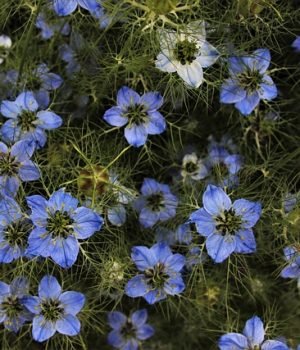
#30. Love-in-a-Mist
: Bittersweet Nightshade is native to Europe, Asia, and North America and can be found in a variety of habitats, including wetlands, forests, and disturbed areas. It is known for its attractive,
- Scientific Name: Solanum dulcamara
- Plant Type: Bittersweet Nightshade is a woody perennial vine that is grown for its attractive flowers and berries.
- Sunlight Needs: Bittersweet Nightshade prefers full sun to partial shade.
- Plant Size: Bittersweet Nightshade can grow up to 10-12 feet (3-3.6 meters) long.
- Growing Zones: Bittersweet Nightshade is hardy in USDA growing zones 3-9.
- Soil Needs: Bittersweet Nightshade prefers well-drained soil that is neutral to slightly acidic (pH 6.0-7.0).

#31.Anemone
Blazing Stars are native to North America and are commonly found in meadows, prairies, and other open habitats. They are known for their long, spiky flowers that come in shades of pink, purple, and white.
- Scientific Name: Liatris spicata
- Plant Type: Blazing Stars, also known as Gayfeather, are herbaceous perennial plants that are grown for their tall, spiky flowers.
- Sunlight Needs: Blazing Stars prefer full sun to partial shade.
- Plant Size: Blazing Stars can grow up to 2-5 feet (60-150 cm) tall and 1-2 feet (30-60 cm) wide.
- Growing Zones: Blazing Stars are hardy in USDA growing zones 3-9.
- Soil Needs: Blazing Stars prefer well-drained soil that is moist and slightly acidic to neutral (pH 6.0-7.0).

